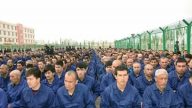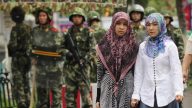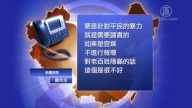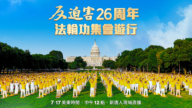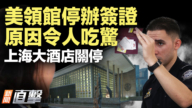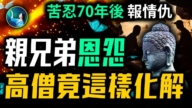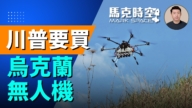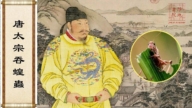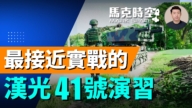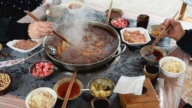【新唐人2014年05月08日讯】周二,中国国际关系学院“国际战略与安全研究中心”,发布了首部《国家安全蓝皮书》,强调恐怖活动呈现高发状态,已成为威胁国家安全的最大问题。评论分析,中国最大的“恐怖主义”份子是中共本身。
这份题为《中国国家安全研究报告(2014)》的蓝皮书,是由“国际关系学院国际战略与安全研究中心”和《社会科学文献出版社》联合发布,对去年中国国家安全形势进行回顾、评估与分析。
蓝皮书指出:中国境内恐怖活动相对前几年,处于活跃期,报告统计,去年中国境内的所谓暴力恐怖主义袭击共10起。
蓝皮书认为,中国的恐怖活动呈现出地域扩大的趋势,和以政府机构和军警为主要袭击目标,以及恐怖势力使用冷兵器等简陋工具作案的新特点。
中国现代国际关系研究院副院长冯仲平说:“目前国内安全面临的最大威胁之一就是暴力恐怖主义。”
国际上针对“恐怖主义”一词,主要是指为达成宗教、政治或意识形态上的目地而有意制造恐慌的暴力行为。
美国哥伦比亚大学访问学者陈破空:“在中共的定义里面,如果用暴力的叫做恐怖份子。不用暴力的,比如说,学伊斯兰教的主张民族自治,主张民族独立的,它可能也叫恐怖份子,叫和平的恐怖份子,所以中共这个定义非常广泛,它打击面很广,竖敌很多。”
美国“哥伦比亚大学”访问学者陈破空指出,加上中共高压的、强硬的治疆政策,以及对各个阶层民众的打压,激起了越来越多的反抗。
香港《开放》杂志总编辑金钟:“从根本上来讲呢,我觉得共产党的暴力理论啊,它们从来没有批评过,批判过,反省过,为什么?因为它们整个政权就是靠暴力得到的嘛,枪杆子里面出政权嘛,所以它根本就否认这种用和平,用民主的方式来建立一个国家,来建立一个制度。”
时政评论员汪北稷指出,中共以暴力革命起家,从第一代党魁毛泽东开始就擅长武装斗争,共产党的宣言以及它的行为准则、它的话语里面,倡导的都是暴力。
时政评论员汪北稷:“现在当一些民族问题的激化,贫富问题的激化,社会暴动的激化,造成了中共本身也成为暴力的袭击目标的时候,它来反对所谓的暴恐,但是暴力恐怖问题它是有原因的,它的根源还是在社会的矛盾当中存在。”
汪北稷举出:中国目前的贫富差距,民族问题,社会阶层问题,贪污腐败,环境恶化等社会矛盾,都可能导致某些群体的心理绝望,而选择报复政府和社会。
汪北稷:“但是有一些公安机关,政府部门啊成为暴力恐怖袭击的目标,它们需要反思它们自己的过去的所作所为。”
中共发布蓝皮书当天,广州火车站再次发生持刀砍人事件,造成6人受伤。这是近两个月来,发生在大陆火车站的第3起恐怖血案。
4月底,新疆乌鲁木齐火车站发生血案,造成3死70多人受伤﹔而3月初,云南昆明火车站已发生砍人事件,导致29人死,140多人伤﹔去年10月,天安门广场发生驾车撞人事件,导致5人死,多名行人受伤。
这些血案都被中共定性为恐怖袭击。蓝皮书强调,所谓“三股势力”在新疆和西藏制造的恐怖袭击事件,背后都有深刻的国际背景。
陈破空:“中共把维吾尔人定义了三种势力,一种叫做宗教极端势力,一种叫民族分裂势力,一种叫暴力恐怖势力,实际上这三种势力,中共定义完了,都定义它自己,因为民族分裂是中共造成的。”
陈破空指出,新疆、西藏几千年来都与汉人相安无事,但中共建政以来,以暴力手段和恐怖主义对付维吾尔人和藏人,所以说,最大的“恐怖主义”份子是中共本身。
采访编辑/李韵 后制/舒灿
With Frequent Attacks Occurring, Communist China Publishes First Security Blue Book
On May 7, China released its first national
security blue book.
It emphasizes rising terrorist attacks in China
has become the biggest national security threat.
However, experts say that the biggest terrorist in China
is the Chinese Communist Party (CCP).
The Blue Book was jointly published by China ‘s University
of International Relations and Social Science Academic Press.
It reviews and analyzes China ‘s national security
status in 2013.
The Blue Book states that terrorists are in an active period
compared to years past.
The report states that there were 10 “terrorist attacks"
in China last year.
The Blue Book suggests that terrorist attacks in China
have expanded to targeted regions.
They are mainly aiming at government organs,
the police and the army.
It says the recent pattern of terrorists is to use simple
tools to commit crimes.
Feng Zhongping, deputy director of China Institutes
of Contemporary International Relations says that
the biggest security threat is violent terrorism.
Among the international community, terrorism refers
to those violent acts that are intended to create terror
or are perpetrated for a religious, political or ideological goal.
Chen Pokong, visiting scholar, Columbia University:
“The CCP defines a terrorist as one who uses violence.
If there is no use of violence, for example, learning
from Islam ‘s idea of national autonomy and independence,
the CCP likely calls it terror or peaceful terror.
Thus the CCP stretches the definition of terrorism, and in this
way, it purges large areas, creating many enemies."
Chen Pokong points out that the CCP ‘s brutal suppression,
forceful implementation of the Xinjiang policy
and suppression of people from all walks of life
has sparked a growing resistance.
Jin Zhong, Chief Editor of Hong Kong ‘s Open Magazine:
“Fundamentally speaking, I think the party has never
criticized or reviewed its theory of violence.
Why?
Because the CCP obtained its power by using violence,
saying ‘power grows from the barrel of the gun. ‘
So, they completely deny that the establishment of a nation
or a system should follow the way of peace and democracy."
Wang Beiji, current affairs commentator, says that the CCP
grew out of violence, beginning with its first generation –
Mao Zedong– who was good at struggle.
Its words in the Declaration of the Communist Party
and its code of conduct advocate violence.
Wang Beiji: “Now ethnic conflict, problems between poor
and rich, and the social violence have intensified,
and the CCP has become the target of attackers.
In this regard, the CCP began implementing
‘anti terrorism.However ‘, there are reasons for the terror,
the root of the cause exists inside the social conflicts."
Wang Beiji listed the wealth gap, ethnic issues,
social class issues, corruption, environmental deterioration
and more, as causing despair in certain groups, which has
lead people to retaliate in the government and society.
Wang Beiji: “Some police stations and governmental organs
become terrorists targets, they must examine
its past behaviors."
The same day the Blue Book was released, a knife attack
took place again at the Guangzhou Railway station.
Six people were injured.This is the third bloody railway station attack
in China within two months.
At end of April, a massacre occurred at Urumqi Railway
Station in Xinjiang Province.
Three people died, 70 were injured.At beginning of March, a knife attack took place at Kunming Railway Station in Yunnan.It caused 29 deaths and 140 injuries.
In October 2013, a Tiananmen Square car crash incident
killed five people and injured many bystanders.
The CCP classified these incidents as terrorist attacks.
The Blue Book stresses that the “three forces" that caused
the Xinjiang and Tibet attacks are being influenced
by international terrorism.
Chen Pohong: “The CCP classified Uyghurs
into three forces— the religious extreme force,
ethnic separation force, and the violent terrorism force.
Actually, all the three categories created by the CCP can be reversed back on itself.Because the ethnic separation was caused by the CCP."
Chen Pokong points out that Uyghurs and Tibetans have
gotten along well with Han people for thousands of years,
however, when the CCP took over the country, they used
violence and terrorism to deal with Uyghurs and Tibetans.
Thus the CCP is the largest terrorist.
Interview & Edit/Liyun Post-Production/SuCan


